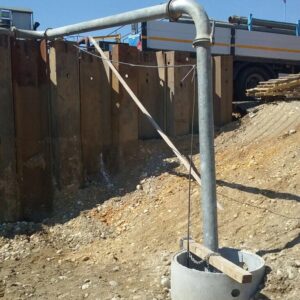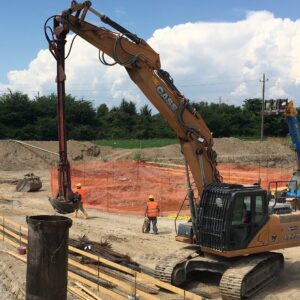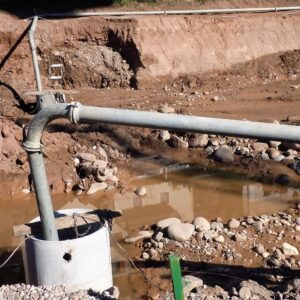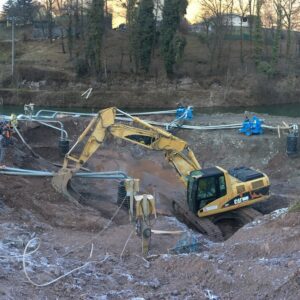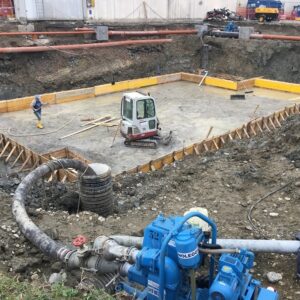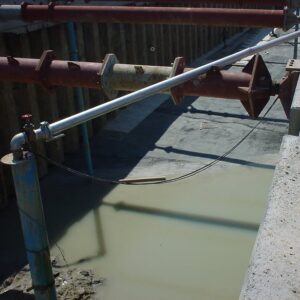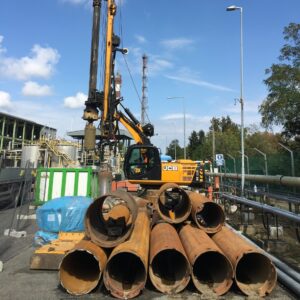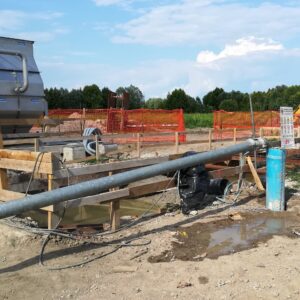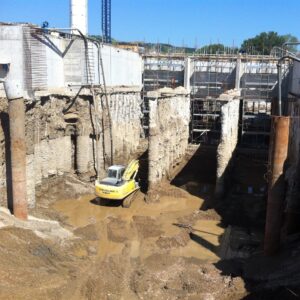
DRAINING WELLS
We have already highlighted how the type of soil influences the choice of the drainage technique to be used. In the presence of gravel, the soil becomes very permeable, thus making the wellpoint points difficult to use for two reasons. Firstly, the resistance opposed by the gravel to driving. Secondly, the fact that in such soils the pumping capacity of the wellpoint system is insufficient compared to the potential of the groundwater. The water flow, in fact, is subject to a strong supply from the subsoil due to high underpressures. The number of wellpoint filters to be used would become practically unlimited, followed by a series of negative implications.
To overcome this limit (or where the spaces for the wellpoint system are not sufficient), drainage wells are installed and behave like macro-wellpoints. Inside these wells, specific pumps are installed (submersible or submersible depending on the case), allowing the extraction of large quantities of water and the consequent lowering of the groundwater level in the adjacent area. The extraction depth that can be reached by these pumps is much greater than that of the wellpoints.
WELLS IN CLE / CLS
CLE wells are the simplest method for extracting large quantities of water in highly permeable soils. Inside these wells specific pumps are inserted. They are automatically triggered when the water level rises, and stop when the level falls within the safe altitude. To carry them out, a grapple digs into a 1000mm self-sinking iron jacket (which will be then removed). Once the well has been dug, previously drilled concrete rings (diameter 800) are inserted inside through a “calatubi”, until reaching the top of the well. The remaining space around the well is filled with coarse gravel, which filter the water coming from all the upper layers, acting as a prefilter for the system.
WELLS IN PVC / HDPE
In some specific cases, where there is a need, we can propose the solution of wells in plastic materials, in place of concrete wells. In this case there is also the possibility of pre-filtering the well itself with drained fabric and material to manage lithographic situations where wellpoints or the more traditional wells in CLS fail to operate correctly.
DEEP WELLS
Deep wells are made when the depths to be reached are very high and the excavation spaces are excessive for the type of construction site. Specific drilling machines are used to dig several meters below the depth of the excavation. Then, steel jacketed-wells or PVC sheaths are inserted. Inside these jackets, specific high-head pumps are inserted to allow the groundwater level to be lowered by many meters, without proceeding with subsequent excavations as, instead, may occur with traditional wells or wellpoint systems.
WELLS IN DEPRESSION
In some specific cases, we are also able to propose depression (or vacuum) wells that combine the flow rate and prevalence of the wells with the suction power of the wellpoint systems, where the whole system works in a vacuum. In these systems, the entire well (including the pump) is positioned inside a watertight chamber that depresses the entire suction area allowing the well to work more efficiently.


